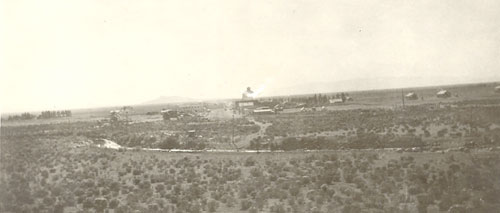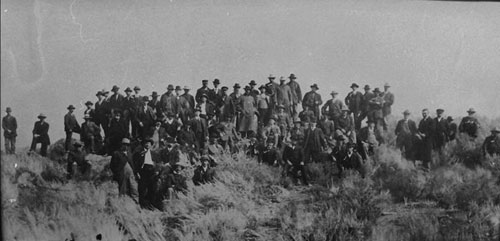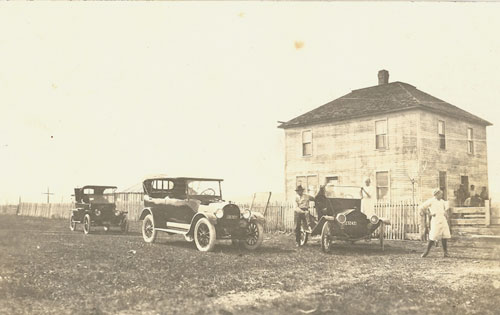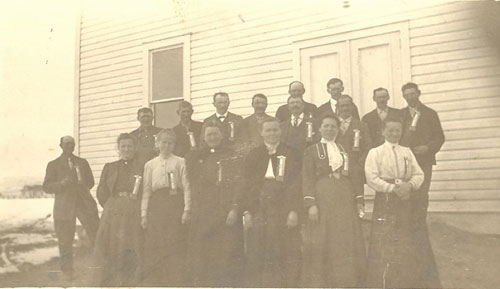By Lee Juillerat, Shaw Historical Library Board Member
(Reprinted from the Herald and News with permission)

Malin Celebrated it's 100th Anniversary in 2009
It was 1909 when a group of Czechoslovakian colonists stood on a small sagebrush hill at the shore of Tule Lake visualizing a future community at the shores of a receding lake that only a few years earlier had covered the land. Until the early 1900s what is now the city of Malin had been submerged. Part of the lake shrunk in size when the U.S. Bureau of Reclamation reclaimed its waters to encourage settlement and development by farmers and their families.
Three advance scouts - A.J. Svoboda and Frank Zumpfe from Nebraska and Vaclav Vostricil from Oklahoma - had traveled the American West searching for an area to develop a community earlier in 1909. They settled, literally, on an area of sandy, black loam soil then mostly populated by ducks and geese. That September, 50 families from the Czech Colonization Club, who learned about the settlement project from Hospodar, a Bohemian agricultural magazine, rode by train from Omaha, Nebraska to Klamath Falls. From there they traveled the final 30 miles in horse-drawn hacks, made small down payments and began creating lives.

Most the early colonists traced their roots to Bohemia. Descendants of the early arrivals, people with names like Cacka, Havlina, Victorine, Micka, Stastny and Kalina, are remembering their ancestors with several festivities through the year. In February they held a jaternice dinner, which featured the garlic-heavy Czech sausage and other traditional foods, like strudel, sauerkraut and kolaches.
While various events are planned, the celebration will kick loose July 17 to 19, 2009 with a parade, pit-beef barbecue, museum displays, all-class reunion, and two Czech traditions, performances of the Beseda, the Czech national dance performed by girls and women in traditional red skirts and frilly white shirts and boys and men with red vests and yellow sashes, and Sokol gymnastics demonstrations.
The city's name reflects the city's heritage. Legend says Mrs. Frank Zumpfe, who with her husband was among the original arrivals, found a large horseradish root growing and chose the name to honor the Bohemian horseradish found in Malin, Czechoslovakia.

Among the centennial's organizers is Denny Kalina, the grandson of A Kalina, another original settler. Denny is a leader of the Malin Historical Society, a group transforming the long-vacant Malin Drug Store into a museum that will feature historic photos and displays. "People with Malin backgrounds are coming back for the celebration," Kalina says.
A series of events are planned, including a Fourth of July car show and parade, August quilt show, November bazaar, dedication of a brass plaque in the Malin Community Park. "We've got lots of projects," Kalina promises.
Malin's History
Settlement in what is now Malin was not easily done. In a story in "A Bit of Old Bohemia: 70th anniversary Malin, Oregon," a special supplement in the 1979 Herald and News, Marge Burleigh wrote about some of the difficulties:
“The sagebrush grew rank and high, sometimes five feet tall, causing hardship to both men and women, who had to grub it out by hand. Wind and dust blew through the cracks of the hastily built cabins. Women worked side by side with the men in the fields shocking grain, pitching hay, shoveling ditches. They made beds of meadow hay and furniture from used boxes. It was not uncommon for the settlers to work by lantern light far into the night."
As Burleigh also wrote: "The pioneers must have wondered at their settlement choice in the early years, when they suffered many hardships. Crops that didn't freeze or which weren't destroyed by winds were eaten by jackrabbits.

"To control rabbits, drives were started. Louis Kalina, son of Alois Kalina, recalls joining a rabbit drive when he was about 10 years old. The drive, with participants walking, riding horseback or driving wagons, began about 10 a.m. on the California side of the state line near Horse Mountain and ended late in the afternoon at a wired-off area northeast of Malin.
"About 4,000 rabbits were caged. Young boys from the community were instructed to kill them with clubs. As Kalina recalls, 'This wasn't sport, but a necessity to save the farm crops.'
"A bounty of five cents for each set of rabbit ears was offered. With part of the money chicken wire was bought to build pens. Other bounties bought shoes and overalls."
* * *
For information about Malin Centennial activities call Denny Kalina at (541)723-2681, Kay Neumeyer at (541)723-2021, or write the Malin Historical Society, P.O. Box 29, Malin, OR 97632. The web site has more information www.cityofmalin.org.

